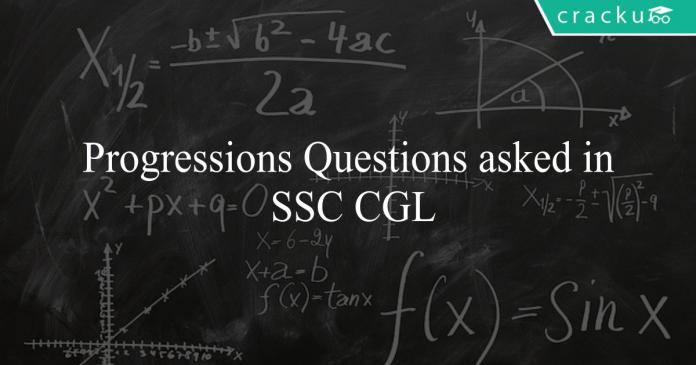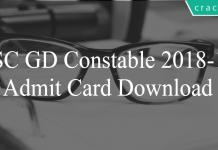Progressions Questions asked in SSC CGL:
Download SSC CGL Questions on Progressions with answers PDF based on previous papers very useful for SSC CGL exams. Top-10 Very Important History Questions for SSC Exams.
Download Progressions Questions asked in SSC CGL
Get 200 SSC mocks for just Rs. 249. Enroll here
Take a free mock test for SSC CGL
Download SSC CGL Previous Papers PDF
More SSC CGL Important Questions and Answers PDF
Question 1: The first and last terms of an arithmetic progression are -32 and 43. If the sum of the series is 88, then it has how many terms?
a) 16
b) 15
c) 17
d) 14
Question 2: Find the value of p if 3x + p, x – 10 and -x + 16 are in arithmetic progression.
a) 16
b) 36
c) -16
d) -36
Question 3: The 4th term of an arithmetic progression is 15, 15th term is -29, find the 10th term?
a) -5
b) -13
c) -17
d) -9
Question 4: In an arithmetic progression if 13 is the 3rd term, 47 is the 13th term, then 30 is which term?
a) 9
b) 10
c) 7
d) 8
Question 5: The first and last terms of an arithmetic progression are 37 and -18. If the sum of the series is 114, then it has how many terms?
a) 13
b) 12
c) 14
d) 15
SSC CGL Previous Papers Download PDF
Question 6: In an arithmetic progression, if 17 is the 3rd term, -25 is the 17th term, then -1 is which term?
a) 10
b) 11
c) 9
d) 12
Question 7: In an arithmetic progression, if 9 is the 5th term, -26 is the 12th term, then -6 is which term?
a) 11
b) 8
c) 10
d) 7
Question 8: Find the value of p, if 2x – 4, 4x + p and 6x – 12 are in arithmetic progression.
a) -9
b) -10
c) -11
d) -8
Question 9: Find the value of p if -3x – 11, x + p and 5x + 7 are in arithmetic progression.
a) 9
b) 2
c) -9
d) -2
Question 10: The first and last terms of an arithmetic progression are 29 and -49. If the sum of the series is -140, then it has how many terms?
a) 13
b) 14
c) 12
d) 11
18000+ Questions – Free SSC Study Material
Answers & Solutions:
1) Answer (A)
First term of AP, $a=-32$ and last term, $l=43$
Let there be $n$ terms
Sum of AP = $\frac{n}{2}(a+l) = 88$
=> $\frac{n}{2}(-32+43)=88$
=> $\frac{11n}{2}=88$
=> $n=88 \times \frac{2}{11}$
=> $n=8 \times 2=16$
=> Ans – (A)
2) Answer (D)
Terms in arithmetic progression : $(3x + p) , (x – 10) , (-x + 16)$
=> Difference between first two terms is equal to the difference between last two terms
=> $(x – 10) – (3x + p) = (-x + 16) – (x – 10)$
=> $-2x -10 – p = -2x + 16 + 10$
=> $-p = 26 + 10 = 36$
=> $p = -36$
=> Ans – (D)
3) Answer (D)
The $n^{th}$ term of an A.P. = $a + (n – 1) d$, where ‘a’ is the first term , ‘n’ is the number of terms and ‘d’ is the common difference.
4th term, $A_4 = a + (4 – 1) d = 15$
=> $a + 3d = 15$ —————–(i)
Similarly, 15th term, $A_{15} = a + 14d = -29$ ——————(ii)
Subtracting equation (i) from (ii), we get :
=> $(14d – 3d) = -29 – 15$
=> $d = \frac{-44}{11} = -4$
Substituting it in equation (i), => $a – 12 = 15$
=> $a = 15 + 12 = 27$
$\therefore$ 10th term, $A_{10} = a + (10 – 1)d$
= $27 + (9 \times -4) = 27 – 36 = -9$
=> Ans – (D)
4) Answer (D)
The $n^{th}$ term of an A.P. = $a + (n – 1) d$, where ‘a’ is the first term , ‘n’ is the number of terms and ‘d’ is the common difference.
3rd term, $A_3 = a + (3 – 1) d = 13$
=> $a + 2d = 13$ —————–(i)
Similarly, 13th term, $A_{13} = a + 12d = 47$ ——————(ii)
Subtracting equation (i) from (ii), we get :
=> $(12d – 2d) = 47 – 13 = 34$
=> $d = \frac{34}{10} = 3.4$
Substituting it in equation (i), => $a + 2 \times 3.4 = 13$
=> $a = 13 – 6.8 = 6.2$
Let $n^{th}$ term = 30
=> $a + (n – 1) d = 30$
=> $6.2 + (n – 1) (3.4) = 30$
=> $(n – 1) (3.4) = 30 – 6.2 = 23.8$
=> $(n – 1) = \frac{23.8}{3.4} = 7$
=> $n = 7 + 1 = 8$
5) Answer (B)
In an arithmetic progression with first term, $a = 37$ , last term, $l = -18$
Let number of terms = $n$
$\therefore$ Sum of A.P. = $\frac{n}{2} (a + l) = 114$
=> $\frac{n}{2} (37 – 18) = 114$
=> $19n = 114 \times 2 = 228$
=> $n = \frac{228}{19} = 12$
=> Ans – (B)
6) Answer (C)
The $n^{th}$ term of an A.P. = $a + (n – 1) d$, where ‘a’ is the first term , ‘n’ is the number of terms and ‘d’ is the common difference.
3rd term, $A_3 = a + (3 – 1) d = 17$
=> $a + 2d = 17$ —————–(i)
Similarly, 17th term, $A_{17} = a + 16d = -25$ ——————(ii)
Subtracting equation (i) from (ii), we get :
=> $(16d – 2d) = -25 – 17$
=> $d = \frac{-42}{14} = -3$
Substituting it in equation (i), => $a – 6 = 17$
=> $a = 17 + 6 = 23$
Let $n^{th}$ term = -1
=> $a + (n – 1) d = -1$
=> $23 + (n – 1) (-3) = -1$
=> $(n – 1) (-3) = -1 – 23 = -24$
=> $(n – 1) = \frac{-24}{-3} = 8$
=> $n = 8 + 1 = 9$
7) Answer (B)
The $n^{th}$ term of an A.P. = $a + (n – 1) d$, where ‘a’ is the first term , ‘n’ is the number of terms and ‘d’ is the common difference.
5th term, $A_5 = a + (5 – 1) d = 9$
=> $a + 4d = 9$ —————–(i)
Similarly, 12th term, $A_{12} = a + 11d = -26$ ——————(ii)
Subtracting equation (i) from (ii), we get :
=> $(11d – 4d) = -26 – 9$
=> $d = \frac{-35}{7} = -5$
Substituting it in equation (i), => $a – 20 = 9$
=> $a = 9 + 20 = 29$
Let $n^{th}$ term = -6
=> $a + (n – 1) d = -6$
=> $29 + (n – 1) (-5) = -6$
=> $(n – 1) (-5) = -6 – 29 = -35$
=> $(n – 1) = \frac{-35}{-5} = 7$
=> $n = 7 + 1 = 8$
8) Answer (D)
Terms in arithmetic progression : $(2x – 4) , (4x + p) , (6x – 12)$
=> Difference between first two terms is equal to the difference between last two terms
=> $(4x + p) – (2x – 4) = (6x – 12) – (4x + p)$
=> $2x + p + 4 = 2x – 12 – p$
=> $2p = -12 – 4 = -16$
=> $p = \frac{-16}{2} = -8$
9) Answer (D)
Terms in arithmetic progression : $(-3x – 11) , (x + p) , (5x + 7)$
=> Difference between first two terms is equal to the difference between last two terms
=> $(x + p) – (-3x – 11) = (5x + 7) – (x + p)$
=> $4x + p + 11 = 4x + 7 – p$
=> $2p = 7 – 11 = -4$
=> $p = \frac{-4}{2} = -2$
=> Ans – (D)
10) Answer (B)
In an arithmetic progression with first term, $a = 29$ , last term, $l = -49$
Let number of terms = $n$
$\therefore$ Sum of A.P. = $\frac{n}{2} (a + l) = -140$
=> $\frac{n}{2} (29 – 49) = -140$
=> $\frac{-20n}{2} = -140$
=> $n = \frac{(-140) \times 2}{-20} = 7 \times 2$
=> $n=14$
=> Ans – (B)
Get 200 SSC mocks for just Rs. 249. Enroll here
We hope this Progressions Questions for SSC CGL Exam preparation is so helpful to you.





